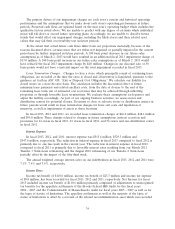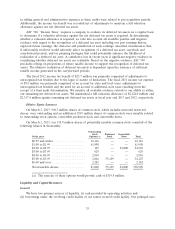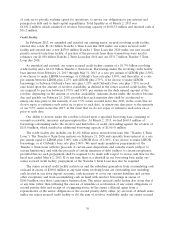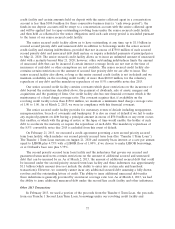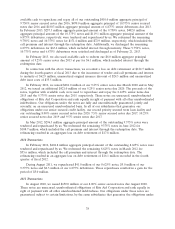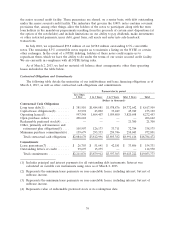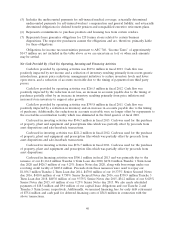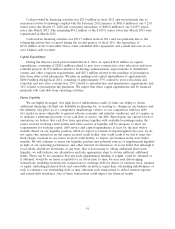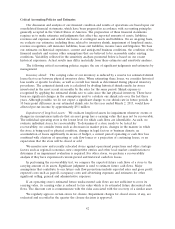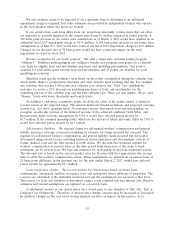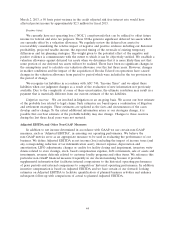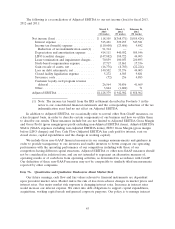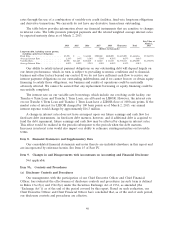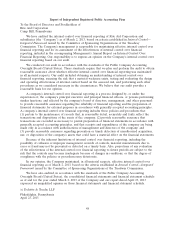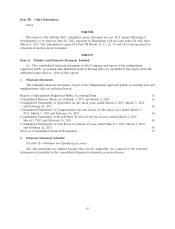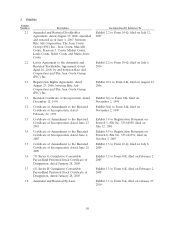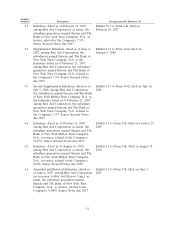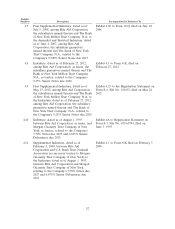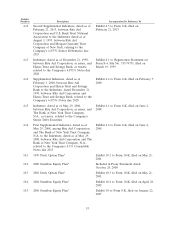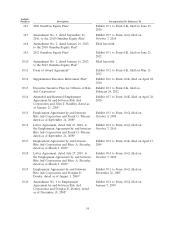Rite Aid 2013 Annual Report Download - page 45
Download and view the complete annual report
Please find page 45 of the 2013 Rite Aid annual report below. You can navigate through the pages in the report by either clicking on the pages listed below, or by using the keyword search tool below to find specific information within the annual report.March 2, 2013, a 50 basis point variance in the credit adjusted risk free interest rate would have
affected pretax income by approximately $2.3 million for fiscal 2013.
Income taxes:
We currently have net operating loss (‘‘NOL’’) carryforwards that can be utilized to offset future
income for federal and state tax purposes. These NOLs generate significant deferred tax assets which
are currently offset by a valuation allowance. We regularly review the deferred tax assets for
recoverability considering the relative impact of negative and positive evidence including our historical
profitability, projected taxable income, the expected timing of the reversals of existing temporary
differences and tax planning strategies. The weight given to the potential effect of the negative and
positive evidence is commensurate with the extent to which it can be objectively verified. We establish a
valuation allowance against deferred tax assets when we determine that it is more likely than not that
some portion of our deferred tax assets will not be realized. There have been no significant changes in
the assumptions used to calculate our valuation allowance over the last three years. However, changes
in market conditions and the impact of the acquisition of Brooks Eckerd on operations have caused
changes in the valuation allowance from period to period which were included in the tax provision in
the period of change.
We recognize tax liabilities in accordance with ASC 740, ‘‘Income Taxes’’ and we adjust these
liabilities when our judgment changes as a result of the evaluation of new information not previously
available. Due to the complexity of some of these uncertainties, the ultimate resolution may result in a
payment that is materially different from our current estimate of the tax liabilities.
Litigation reserves: We are involved in litigation on an on-going basis. We accrue our best estimate
of the probable loss related to legal claims. Such estimates are based upon a combination of litigation
and settlement strategies. These estimates are updated as the facts and circumstances of the cases
develop and/or change. To the extent additional information arises or our strategies change, it is
possible that our best estimate of the probable liability may also change. Changes to these reserves
during the last three fiscal years were not material.
Adjusted EBITDA and Other Non-GAAP Measures
In addition to net income determined in accordance with GAAP, we use certain non-GAAP
measures, such as ‘‘Adjusted EBITDA’’, in assessing our operating performance. We believe the
non-GAAP metrics serve as an appropriate measure to be used in evaluating the performance of our
business. We define Adjusted EBITDA as net income (loss) excluding the impact of income taxes (and
any corresponding reduction of tax indemnification asset), interest expense, depreciation and
amortization, LIFO adjustments, charges or credits for facility closing and impairment, inventory write-
downs related to store closings, stock- based compensation expense, debt retirements, sale of assets and
investments, revenue deferrals related to customer loyalty programs and other items. We reference this
particular non-GAAP financial measure frequently in our decision-making because it provides
supplemental information that facilitates internal comparisons to the historical operating performance
of prior periods and external comparisons to competitors’ historical operating performance. In addition,
incentive compensation is based on Adjusted EBITDA and we base certain of our forward- looking
estimates on Adjusted EBITDA to facilitate quantification of planned business activities and enhance
subsequent follow-up with comparisons of actual to planned Adjusted EBITDA.
44


